It’s not a war! It’s just killing.
We’re just about halfway through August and in some parts of the world kids are getting ready to go back to school, a lot of vacations have run their course and folks are already making plans for Labor Day. In other words – summer is almost over! (That is, in the northern hemisphere…) So for this week’s Eclipse column, I figured I better find a summer movie to review while there’s still time. And I’ve landed on the perfect choice: Nagisa Oshima’s Japanese Summer: Double Suicide, from Eclipse Series 21: Oshima’s Outlaw Sixties. Besides the obvious seasonal theme indicated in the title, I figure this is a good title to review for a few other reasons.
Judging from the accounts of recent acquisitions I’ve seen from last month’s Barnes & Noble sale, the Oshima box appears to be the best selling Eclipse set, at least among people who feel compelled to post lists and photos of their recent DVD purchases online. And as evidence of the radical break with traditional values and conventional narrative structures, Japanese Summer: Double Suicide (hereafter, JS:DS) makes for interesting comparisons to Crazed Fruit, from 1956, another Japanese summer movie about youth gone wild that I reviewed last week over at my Criterion Reflections blog. Pretty amazing what a difference a decade can make… in so many ways. Let’s get into it and see what we can learn about this startling slice of Japanese cinema in 1967, unleashed during the West’s legendary ‘Summer of Love.’
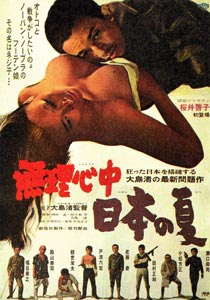

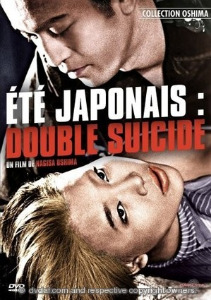
The program begins enigmatically and doesn’t relent much at all over the course of 99 minutes in clarifying director Oshima’s motives or intentions. Suspenseful dissonant 60s soundtrack music with touches of a militaristic drumbeat ushers us in. A young woman in mod attire and one shaved eyebrow wants to use a public bathroom, but a crew of painters are busy covering up the graffiti she admits to creating on its walls (and vows to take elsewhere.) She can’t stop them so she kicks over their paint can and runs away. They chase her on motorcycles but she escapes somehow, winding up on a bridge where she stops to toss her garments into the river.

A group of synchronized swimmers carrying the Japanese flag passing under the bridge inform her that she dropped something and we learn that she no longer needs her underwear since she just broke up with her boyfriend. Parading soldiers show up, igniting her interest in meeting a fresh batch of men, at least one of whom would presumably have some interest in satisfying her craving for sex. But she finds no takers among them. Her gaze wanders over to a group of droning monks who pace in a circle around a chalk drawing on the road of a pair of wounded lovers.
Another wandering stranger, apparently an AWOL soldier, enters the ring and the two of them lay down to replicate with their bodies the pose of the chalk figures. They’re enacting some kind of ritual, but we’re not informed of its meaning. At least she finds a use for her bra and panties, placing them strategically atop the illustrations in the road.

She propositions the man to go somewhere nice for a rendezvous, and he follows, but they wind up in a desolate sun-baked mudflat. She’s partially stripped down and ready to ‘do the wash’ (as she puts it) but he’s in a daze, with other bodily urges on his mind. They’re interrupted by a group of uniformed men who shove the couple aside and start digging right underneath where the man had been laying. They uncover a casket and carry it away, opening it up briefly to reveal its contents: a cache of weapons – guns, rifles, swords!
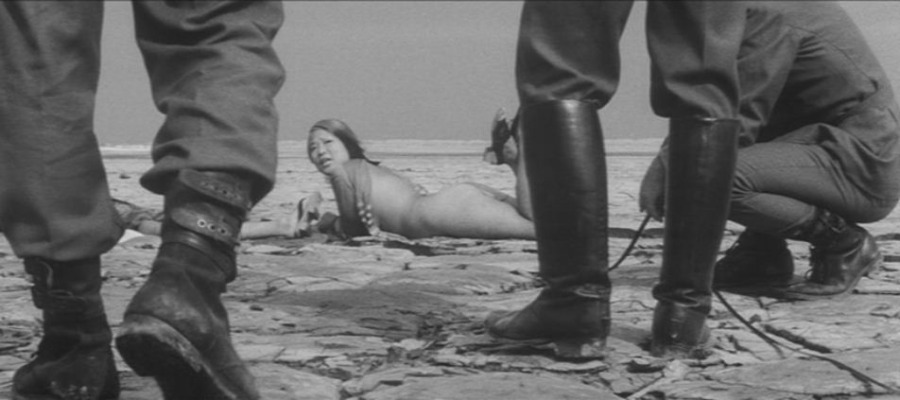
A long walk by the group through the industrial electrical grid to the outskirts of town turns suddenly, silently violent. The man, Otoko, and woman, Nejiko, are taken into the company of a strangely secretive militia and led to their underground bunker, now that they’ve seen too much to be turned loose on their own. Otoko and Nejiko have a hard time making themselves understood – he wants to be on the receiving end of a lethal attack; she just wants to use the bathroom. Even though they are both being held captive by armed and dangerous men, the two intruders appear, by force of will, to have the upper hand.

A handsome and nicely dressed unnamed boy enters the scene. He immediately catches Nejiko’s attention, but he’s not at all interested in becoming the curvaceous girl’s plaything. Foregoing her lusty invitation, he swings to the violent end of the spectrum for his preferred form of release, looking for guns that he suspects are hidden in this compound. He wants to steal one or two to impress his youth gang, but he really has little idea of how to go about the burglary. Soon enough, he’s just another prisoner in this existentially isolated anarchists’ hideout.
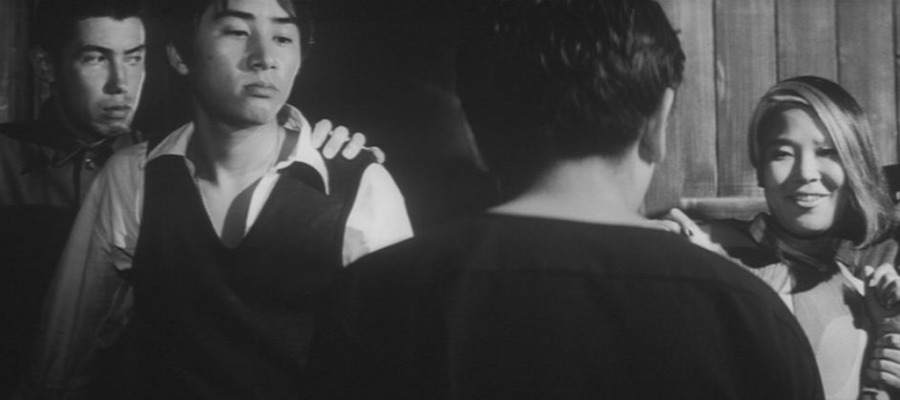
That’s a fairly thorough summary of the first twenty-five minutes of JS:DS, a movie that Oshima made to capture his sense of the ‘death drive’ that ran through the youth culture of his times. As the film proceeds, other characters (and objects) enter the situation. Most notably, an aging, hefty tough guy assassin who likes to fight with old-fashioned implements; a smuggled-in television set, solemnly borne in a white cloth wrapping reminiscent of Mizushima’s funeral box in The Burmese Harp, that provides sketchy updates of a madman on the loose in urban Japan; and a homicidal renegade who arrives late in the film bearing an uncanny resemblance in tactics, appearance and temperament to Lee Harvey Oswald.

The leaders and followers of the gang are mostly side players. Even though we eventually learn a few things about them and the tensions that exist within their group, as the schoolboy claims, they do appear to be ‘cheap gangsters’ without much of a coherent game plan for achieving their vaguely defined goals. That lack of clarity ultimately sets up the narrative tension of JS:DS to be a race to see whose desires are fulfilled to the highest degree of satisfaction: Will Nejiko find a man willing to go to bed with her? Will Otoko realize his ideal of death, where he can see the cold reflection of his face clearly visible in his killer’s eyes? Will the boy get the weapons and the opportunity he so desperately wants to shoot at people?
Each of the three make their own faltering attempts to find that elusive fulfillment, with disappointing results thwarting their desires, though not drastically enough that any of them abandon their quest altogether. The madness of this particular Japanese Summer must lead unalterably through a showdown with the foreign-born killer who’s terrorizing Japan and culminate in the sublimely realized Double Suicide that Nejiko and Otoko have been destined for all along.

If all that I’ve described above seems twisted, nihilistic, pretentious, nonsensical or just irritatingly ridiculous, then consider this essay a friendly favor in persuading you to pass on JS:DS. But if you appreciate directors who aren’t afraid of creating radical environments and situational predicaments that don’t yield up their secrets too easily, I hope it serves as an intriguing invitation to spend time getting to know Oshima’s world.
Here, he seeks to create on screen the atmosphere of semi-improvised avant garde theater, putting a small ensemble cast through their motions without the benefit of a clear back story or an attempt to spell out exactly where the narrative would take them. JS:DS was my first serious sit-down with this notorious, iconoclastic director, who’s been getting a lot of attention from Criterion over the past year, with In The Realm of the Senses and Empire of Passion coming out last fall, the Eclipse set issued this past May and Merry Christmas Mr. Lawrence due for release in October.
The opaque plot and stubborn refusal on Oshima’s part to provide anything close to resembling a tidy explanation of what JS:DS is ‘about’ will undoubtedly frustrate some viewers. (Although Oshima did release this written statement about his creative approach to JS:DS that is essential reading for anyone seriously engaging with the film.) That lack of resolution didn’t bother me at all, since the film offers enough absurd humor and visual intrigue to keep me engaged, and sufficient hints of a creative and provocative intellect behind it all to encourage further exploration. JS:DS, along with the other high-risk provocations included in this set, is yet another incredible relic from cinema’s not-so-distant past – a wondrous reminder of the possibilities that exist beyond the formulaic summer blockbusters that this year in particular have proven to be so heavy in the hype but shallow in their substance.
Related stories:
Check out Joshua’s review of the Eclipse Series 21: Oshima’s Outlaw Sixties from last spring!




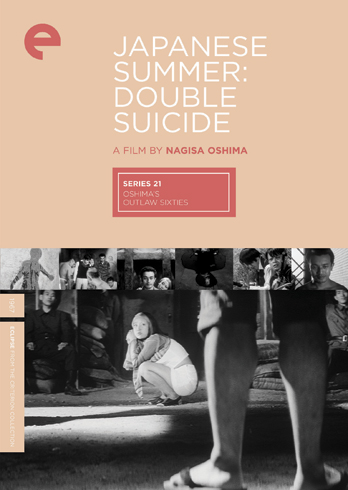

![Bergman Island (The Criterion Collection) [Blu-ray]](https://criterioncast.com/wp-content/uploads/2022/11/bergman-island-the-criterion-collection-blu-ray-400x496.jpg)
![This Is Not a Burial, It’s a Resurrection (The Criterion Collection) [Blu-ray]](https://criterioncast.com/wp-content/uploads/2022/11/this-is-not-a-burial-its-a-resurrection-the-criterion-collection-blu-ray-400x496.jpg)
![Lars von Trier's Europe Trilogy (The Criterion Collection) [The Element of Crime/Epidemic/Europa] [Blu-ray]](https://criterioncast.com/wp-content/uploads/2022/11/lars-von-triers-europe-trilogy-the-criterion-collection-the-element-of-400x496.jpg)
![Imitation of Life (The Criterion Collection) [Blu-ray]](https://criterioncast.com/wp-content/uploads/2022/11/imitation-of-life-the-criterion-collection-blu-ray-400x496.jpg)
![The Adventures of Baron Munchausen (The Criterion Collection) [4K UHD]](https://criterioncast.com/wp-content/uploads/2022/11/the-adventures-of-baron-munchausen-the-criterion-collection-4k-uhd-400x496.jpg)
![Cooley High [Criterion Collection] [Blu-ray] [1975]](https://criterioncast.com/wp-content/uploads/2022/11/cooley-high-criterion-collection-blu-ray-1975-400x496.jpg)
1 comment